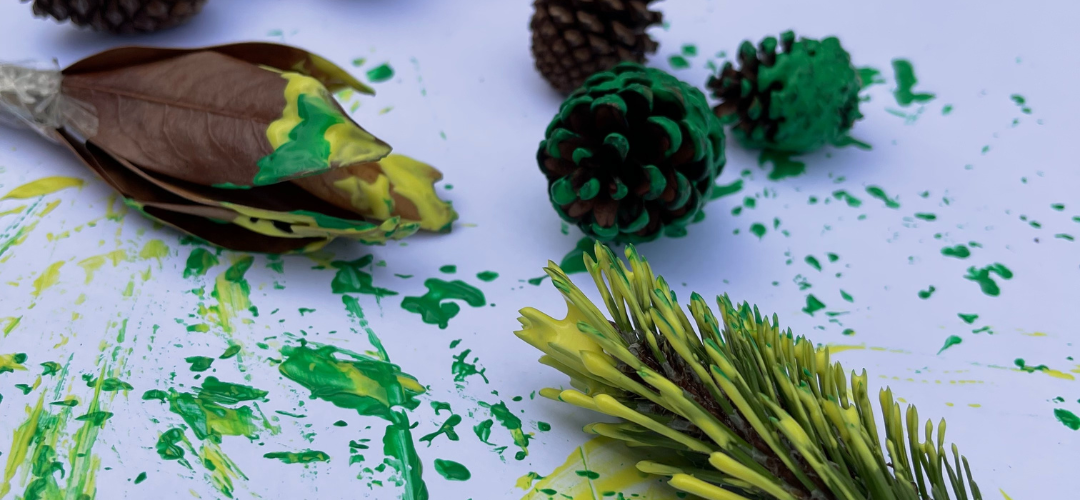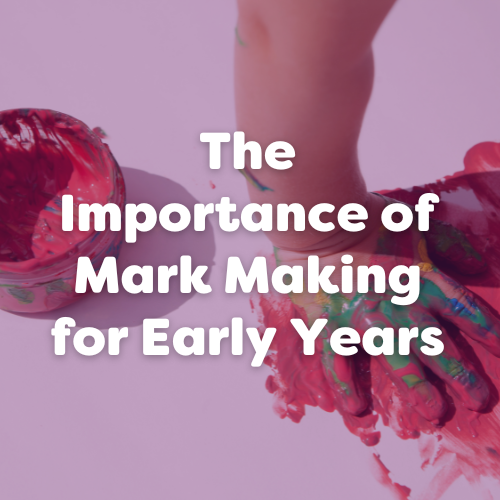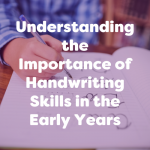Scribbles are products of systematic investigation, rather than haphazard actions
John Matthews
Encourage children to make their mark! Young children have a natural desire to explore and experiment. They relish in the sensory and physical experience of mark-making. This includes the sensation of marker pens gliding across a whiteboard, paint smearing onto an easel, chalk scraping into the tarmac and grains of sand running through their fingers.
Mark-making is much more than just a scribble! Babies and toddlers learn and begin to make sense of the world through mark-making. It is the beginning of a child’s journey towards writing and is an important step in a child’s development. It contributes to handwriting, creativity and coordination. Initially, children take pleasure from the physical activity of mark-making. But as they develop, they realise that they can control their marks and their creativity starts to thrive.
What is mark making?
Mark-making simply refers to the creation of different patterns, lines, textures and shapes. This term is typically used to describe the scribbles that early years children make on a piece of paper. However, this doesn’t just refer to squiggles made with stationery. Children are still making marks if they use their hands, paintbrushes or sticks.
This gives children the opportunity to express themselves and explore new materials other than pen and paper. Encourage them to create marks using their fingers to draw in the sand, paint on an easel or prod them into a soft dough. This activity isn’t just bound to the indoors either. Head outside and engage your children in some outdoor mark-making to explore the natural world and take mark-making to the next level! Let them drag a stick through the mud or go wild with colours with a jumbo Outdoor Kit!

Why is mark-making so important?
A step towards writing…
Research has shown that mark-making is crucial for a child’s development and learning. It not only teaches young children how to hold a pen correctly, but it also prepares them for writing and develops their handwriting skills.
Physical development
When children are making these early marks, they are practising holding a pencil and attempting to control their marks with their muscles. This enhances their physical development by improving their fine motor skills and helps to develop their hand-eye coordination.
Creative representation
Mark-making can also represent a child’s thoughts and ideas. It gives children the opportunity to express themselves creatively and allows them to communicate their feelings through their drawings or even use their marks to tell a story! As they develop, their marks become more complex and sophisticated and their creativity blooms.
Brain and language development
By giving children the opportunity to explore different mediums of mark-making, engages them in sensory play and allows them to discover new exciting materials. This helps to enhance a child’s critical thinking, brain development and language development. Together this gives them the ability to build towards more complex learning tasks in the future. These marks can also support emerging concepts of maths, developing into a mathematical representation and enhancing learning.
How do you encourage mark-making in early years settings?
When trying to encourage mark-making in an early years setting, creating a nurturing and supportive environment where children feel empowered to mark-make is the most important thing to consider. Below are some ways to encourage mark-making in the early years:
- Talk through marks – ask your children what marks they are making and what they mean.
- Provide a range of materials – this variety of materials will stimulate children’s curiosity and interest in experimenting with mark-making.
- Create an inviting space – ensure that you have a dedicated area for mark making, keeping materials organised and accessible so children can freely explore and experiment without restriction.
- Use open-ended prompts – instead of giving children instructions on what to do, offer open-ended prompts or questions like “What do you want to express today?” or “What story are you telling with your marks” This approach encourages children to think creatively and express their own thoughts and feelings
- Connect mark-making to their interests – for example, if your children love animals, try and integrate mark-making activities into small-world animal play. This connection will allow them to be more enthusiastic about mark-making.
- Embrace messiness – provide children with aprons and smocks to protect clothing and ensure that they feel comfortable exploring the mess!
- Modelling and demonstration – visually show children how to use different materials and mark-making techniques.
- Encourage collaboration – try and get your whole early years setting involved. Children love working together on a larger canvas. This is a great way to promote communication and cooperation.
- Document and celebrate – Be sure to take photos of children’s creations and display them in the classroom. This can reinforce their sense of accomplishment and self-esteem.
- Respect unique styles – avoid comparing or criticising work, as this can discourage creativity.
- Get children outdoors – encourage them to adventure outdoors to find materials to mark make with.
- Change up the materials – try to change up the mark-making tools and materials to keep children engaged. This helps to prevent monotony and encourages continued exploration.
- Ask thoughtful questions – ask them questions like “ Why did you choose this colour”, or “What do your marks represent?” This helps promote self-reflection and communication.
How does mark-marking support a child’s learning?
Mark-making plays an important role in supporting a child’s learning and development, especially during the early stages of their education. Mark-making goes beyond just creating art, through mark making children can further their cognitive, social, physical and emotional growth.
Below are some of the ways mark-making helps to support a child’s learning:
- Fine motor skills – Children train small muscles in their hands as they use drawing and writing tools. This helps with the development of fine motor skills, which play an important role in everyday tasks like writing, buttoning clothes and using utensils.
- Hand-eye coordination – as children create marks, they learn to coordinate hand movements and visual inputs. This is essential for tasks like reading, writing and motor control in sports.
- Spatial awareness – creating marks on paper helps children better understand shapes, sizes, proportions and relativity.
- Self-expression – Mark-making allows children to express themselves and their emotions in a nonverbal and creative way. This makes mark-making a great activity for children who struggle to talk and verbalise their feelings.
- Confidence and self-esteem – through mark-making, children can create and watch their efforts turn into visual outcomes freely. This in turn boosts confidence and self-esteem
- Creativity – mark making is a great way for children to explore creating different shapes, colours, sizes and more.
- Problem-solving – children can experiment with different problem-solving tools and determine how to create certain shapes, textures and marks.
- Learning about colour and texture – Mark making with different colours and consistencies of paint can help them learn more about the properties of different colours, colour mixing and textures.
- Pre-writing skills – creating lines, curves and shapes during mark-making lays the foundation for children to learn how to write.
What materials can you use for mark-making?
Below are some great materials to use for mark-making:
- Drawing tools – coloured pencils, crayons, markers, oil pastels, charcoal sticks, jumbo chalk
- Paints – watercolours, finger paints, tempera paints, ready mix paints
- Ink–stamp markers, ink, number stamps
- Natural resources– leaves, twigs, feathers, pine cones. seashells
- Textures – bubble wrap, fabric scraps, mesh
- Household resources – toothbrushes, cotton buds, cotton balls, combs, potato stamps
- Printmaking resources– rollers, rubber stamp
- Sculpting elements – clay and playdough
- Recyclable materials – bottle caps, cardboard tubes, plastic containers
What mark-making resources are available?

There is a huge range of stationery available for mark making – including various colouring pens, markers, crayons, chalks, pastels, pencils, paper and card. But, you’re not bound to stationery. Explore our complete Arts and Crafts and handwriting section on our website to discover an exciting range of different mark making materials – including paints, dough, sand and much more!
We also boast a fantastic selection of kids mark making kits, specifically designed for children to make their mark! Introduce a child to mark making with their very First Set or make it easier for those small hands with the Easi Grip Kit – or why not level up with the funky EYR Rock & Roll Pack. Whatever materials children use, it’s extremely important to encourage mark making for their transition into writing.
On your marks…write!




